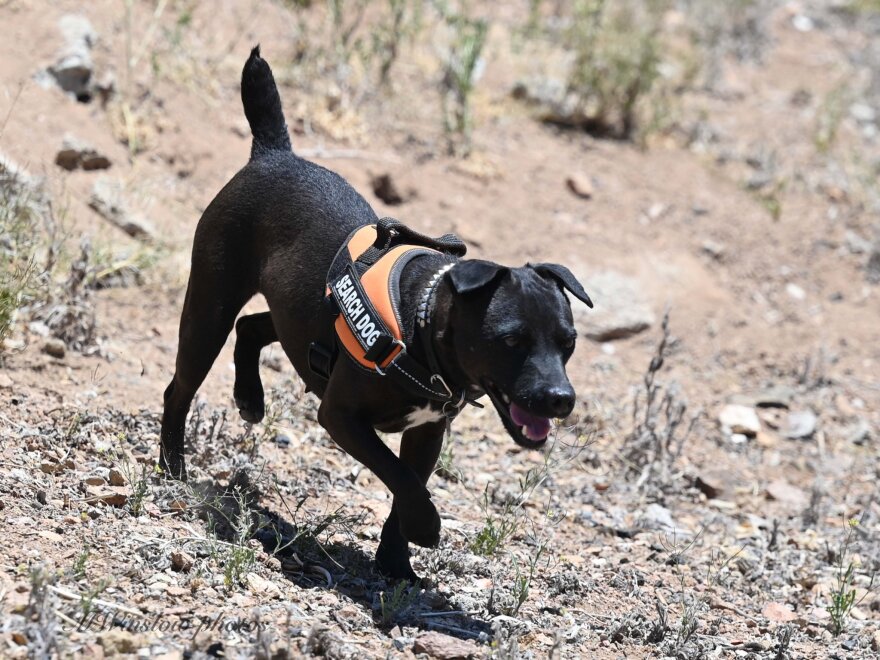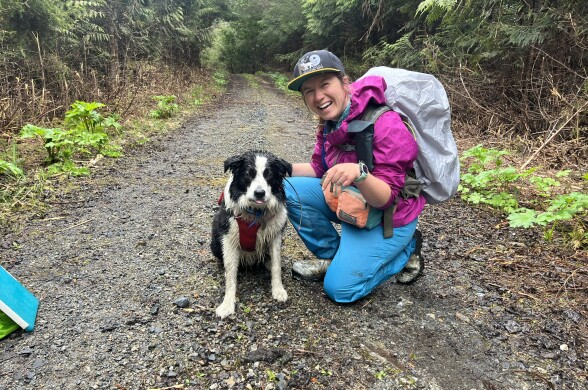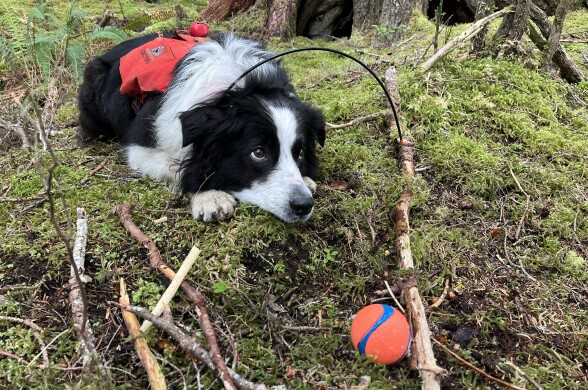Truth matters. Community matters. Your support makes both possible. LAist is one of the few places where news remains independent and free from political and corporate influence. Stand up for truth and for LAist. Make your year-end tax-deductible gift now.
These 'conservation' dogs can sniff out invasive plants and endangered species the size of a nickel

Lauralea Oliver has worked with dogs for most of her life. She grew up with a German Shepherd as a pet, was a dog trainer for many years, worked in animals shelters — all of which led her to dabble in scent work about 15 years ago.
"I met a lot of people — professional handlers that did narcotics, search and rescue," said Oliver, who lives in the community of Acton near Antelope Valley. "I started to feel a pull in that direction."
Oliver is also a big naturalist. So she started researching fields that combine these different interests.
What she happened upon was the then nascent field of using dogs for ecological scent detection. "A marriage made in heaven for me," Oliver said.
At that time, her sidekick was a working dog rescued from a county shelter named George. Today, Oliver owns and run k9inSCENTive in Acton with a small team of trainers and five dogs.
A nose for everything
Their projects have taken them to various parts of California and beyond, working with different plant and animal species, be it detecting a fungal pathogen in Northern California that causes Sudden Oak Death in trees (with Bolt, the cattle dog), to finding and safeguarding the drop-dead gorgeous and heavily poached San Francisco garter snakes in its namesake city (with Muon, the Belgian malinois), to conducting population surveys for the possibly extinct Morro Bay kangaroo rat (with Vector, the now-retired Belgian malinois).
"You'll find that if you talk to conservation dog people, most of the dogs are trained on something that's either state or federally protected, because that's what they need the dogs for," Oliver said.

A majority of her projects, she said, involve finding dead bat and birds at wind or solar farms for impact surveys that are required by the federal government. That work typically falls on Mamba the Labrador retriever mix, another labrador Circe, and Muon.
"They find 80 to 90% of the things that fall from the sky. Previously we'd use a human surveyor to do visual checks and they're not nearly as good, especially with finding small targets like small birds and bats," she said.
A needle in a haystack
Lately, Oliver and her team have been conducting a population count in different areas of Arizona for a species of rare cactus called pediocactus — one of the most trafficked plants in the world.
Not only does the team have to sweep through a large area, these cacti are also tiny.
"Some of them are as small as like a nickel," Oliver said. "The biggest one we found was probably like a quarter."
For several hours in the morning, Circe would tagged team with Muon to search for the plant — with the labrador identifying general areas where the plant is present, and the malinois zeroing in on the cactus.
A discipline founded on poop
The method of using dogs in conservation efforts was documented as far back as the 1890s in New Zealand. The practice started to gain ground in the 1990s, when science figured out how to extract DNA materials from fecal matter, said Kayla Fratt with K9 Conservationists in Oregon.
"All of a sudden finding poop was really valuable, and that's where the dogs really took off," Fratt said, because the technology made more ecological research to be done through fecal-only surveys possible.
And since, Fratt said, "finding poop, which is, for lack of a better phrase, our better bread and butter."
In 2022, K9 Conservationists' very first project was to help train cheetah scat detection dogs in Kenya. Since then, Fratt and her team of trainers and border collie mixes have worked in places ranging from Alaska to look for wolf scat, to Santa Barbara to track the poop of pumas, black bears and other animals.
"From the conservation perspective, if you don't know what an animal is eating, you don't know what part of the ecosystem is most important to protect in order to keep them healthy," Fratt said, who is pursuing a doctorate degree at Oregon State University with a research focus on conservation dogs and hosts a podcast on the topic.
And all it took a handful of expertly trained dogs and their handlers — something unimaginable just three decades ago.
"The way that we all used to survey and get data from a lot of wildlife species was pretty invasive — it's trapping and collaring and following those individual animals," said Alice Whitelaw, a co-founder of the Montana-based nonprofit, Working Dogs for Conservation (WD4C).
As such, as advances in fecal DNA took hold, Whitelaw (then a wolf biologist) and a few like-minded scientists founded WD4C in the mid-1990s to explore using dogs in conservation — one among a few organizations to emerge at the time.
"We were all dog people that just happened to be biologists and ecologists," Whitelaw said. "We reached out to a lot of narcotics officers, and they all thought we were kind of nuts, because we wanted to find poop."
From that starting point of using scat for ecological monitoring of endangered and rare animals, WD4C expanded to other areas: anti-poaching detection; finding invasive plants and species known in the conservation field as biosecurity; and environmental justice, like working with the Blackfoot tribe and the nonprofit Indigenous Vision to identify contaminants in the environment.
"The dogs aren't finding forever chemicals and toxins in the water supply or diseases in the landscape, what they're looking for is mink or otter scat that contains those contaminants," Whitelaw said. "That gives us an idea of what the indigenous population might be facing in terms of their water quality and also their ability to use land and water resources the way they have forever."
'Girls with dogs'
An OG in the field, Whitelaw has the rare vantage point of seeing how dog conservation detection has evolved over the last 30 years.
"Often we would show up to do a project and it was like, 'Oh God, it's the girls and their dogs,'" said Whitelaw. "It just wasn't taken very seriously in the beginning, and now it's taken very seriously worldwide."
As the discipline develops and expands, the conversation has turned to the potential of coming up with a set of standards to maintain the integrity and longevity of the field. But it's not easy.
"Any law enforcement certification, you know, there's very specific things that you test for. Can the dog smell cocaine? Can the dog properly track a human at this distance in these given parameters?" said Whitelaw. "Those things can be more easily tested for than can a dog find Kit fox scat, blunt nosed leopard lizard, invasive plants of four different species, the list is endless."
That's because the abilities of these working dogs are endless.
"Their capacity to not only learn multiple scents, and great numbers of multiple scents, but to remember them for years and years and years. It just still kind of blows me away," Whitelaw said.












